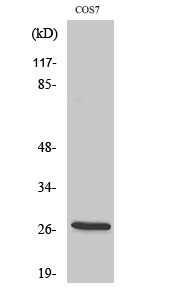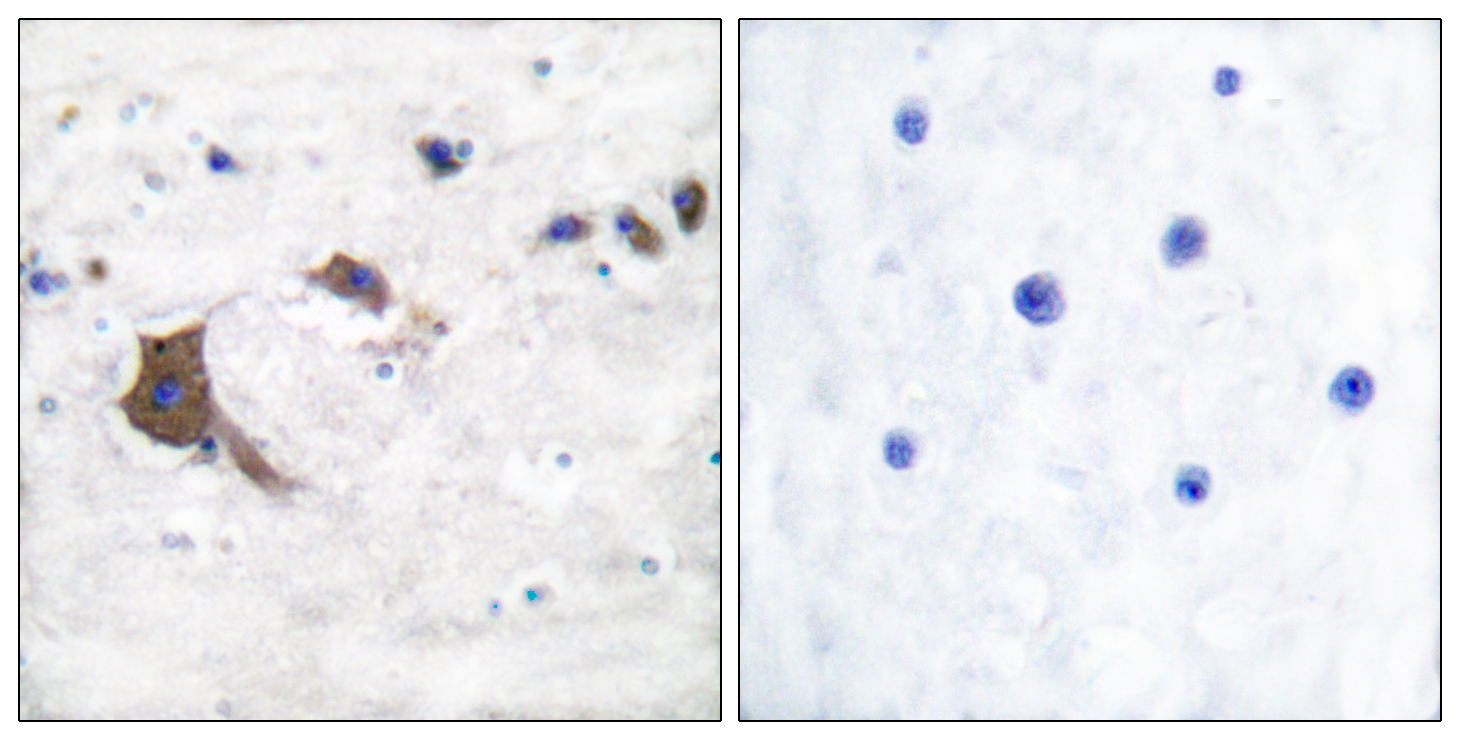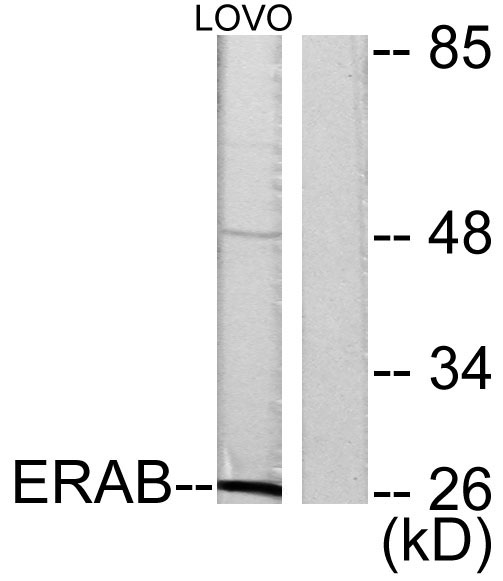ERAB Polyclonal Antibody
- Catalog No.:YT1605
- Applications:WB;IHC;IF;ELISA
- Reactivity:Human;Mouse;Rat;Monkey
- Target:
- ERAB
- Fields:
- >>Valine, leucine and isoleucine degradation;>>Metabolic pathways;>>Alzheimer disease;>>Pathways of neurodegeneration - multiple diseases
- Gene Name:
- HSD17B10
- Protein Name:
- 3-hydroxyacyl-CoA dehydrogenase type-2
- Human Gene Id:
- 3028
- Human Swiss Prot No:
- Q99714
- Mouse Swiss Prot No:
- O08756
- Rat Gene Id:
- 63864
- Rat Swiss Prot No:
- O70351
- Immunogen:
- The antiserum was produced against synthesized peptide derived from human ERAB. AA range:111-160
- Specificity:
- ERAB Polyclonal Antibody detects endogenous levels of ERAB protein.
- Formulation:
- Liquid in PBS containing 50% glycerol, 0.5% BSA and 0.02% sodium azide.
- Source:
- Polyclonal, Rabbit,IgG
- Dilution:
- WB 1:500 - 1:2000. IHC 1:100 - 1:300. ELISA: 1:40000.. IF 1:50-200
- Purification:
- The antibody was affinity-purified from rabbit antiserum by affinity-chromatography using epitope-specific immunogen.
- Concentration:
- 1 mg/ml
- Storage Stability:
- -15°C to -25°C/1 year(Do not lower than -25°C)
- Other Name:
- HSD17B10;ERAB;HADH2;MRPP2;SCHAD;XH98G2;3-hydroxyacyl-CoA dehydrogenase type-2;17-beta-hydroxysteroid dehydrogenase 10;17-beta-HSD 10;3-hydroxy-2-methylbutyryl-CoA dehydrogenase;3-hydroxyacyl-CoA dehydrogenase type II;Endoplasmic
- Observed Band(KD):
- 27kD
- Background:
- This gene encodes 3-hydroxyacyl-CoA dehydrogenase type II, a member of the short-chain dehydrogenase/reductase superfamily. The gene product is a mitochondrial protein that catalyzes the oxidation of a wide variety of fatty acids and steroids, and is a subunit of mitochondrial ribonuclease P, which is involved in tRNA maturation. The protein has been implicated in the development of Alzheimer disease, and mutations in the gene are the cause of 17beta-hydroxysteroid dehydrogenase type 10 (HSD10) deficiency. Several alternatively spliced transcript variants have been identified, but the full-length nature of only two transcript variants has been determined. [provided by RefSeq, Aug 2014],
- Function:
- catalytic activity:(2S,3S)-3-hydroxy-2-methylbutanoyl-CoA + NAD(+) = 2-methylacetoacetyl-CoA + NADH.,catalytic activity:(S)-3-hydroxyacyl-CoA + NAD(+) = 3-oxoacyl-CoA + NADH.,disease:A chromosomal microduplication involving HSD17B10 and HUWE1 is the cause of mental retardation X-linked type 17 (MRX17) [MIM:300705]; also known as mental retardation X-linked type 31 (MRX31). Mental retardation is characterized by significantly sub-average general intellectual functioning associated with impairments in adaptative behavior and manifested during the developmental period. In contrast to syndromic or specific X-linked mental retardation which also present with associated physical, neurological and/or psychiatric manifestations, intellectual deficiency is the only primary symptom of non-syndromic X-linked mental retardation.,disease:Defects in HSD17B10 are the cause of 2-methyl-3-hydroxybutyryl-
- Subcellular Location:
- Mitochondrion . Mitochondrion matrix, mitochondrion nucleoid .
- Expression:
- Ubiquitously expressed in normal tissues but is overexpressed in neurons affected in AD.
- June 19-2018
- WESTERN IMMUNOBLOTTING PROTOCOL
- June 19-2018
- IMMUNOHISTOCHEMISTRY-PARAFFIN PROTOCOL
- June 19-2018
- IMMUNOFLUORESCENCE PROTOCOL
- September 08-2020
- FLOW-CYTOMEYRT-PROTOCOL
- May 20-2022
- Cell-Based ELISA│解您多样本WB检测之困扰
- July 13-2018
- CELL-BASED-ELISA-PROTOCOL-FOR-ACETYL-PROTEIN
- July 13-2018
- CELL-BASED-ELISA-PROTOCOL-FOR-PHOSPHO-PROTEIN
- July 13-2018
- Antibody-FAQs
- Products Images

- Western Blot analysis of various cells using ERAB Polyclonal Antibody

- Immunohistochemistry analysis of paraffin-embedded human brain tissue, using ERAB Antibody. The picture on the right is blocked with the synthesized peptide.

- Western blot analysis of lysates from LOVO cells, using ERAB Antibody. The lane on the right is blocked with the synthesized peptide.



